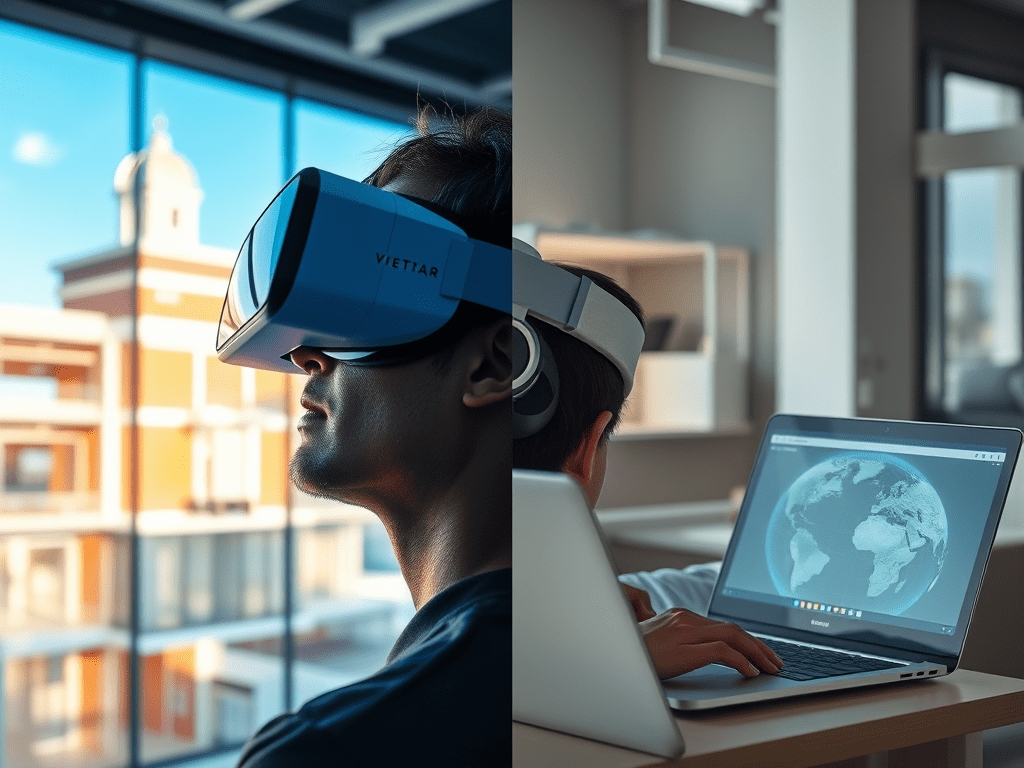Virtual Reality vs. Browser-Based 3D: Which Is Better for Client Presentations?

The way AEC professionals present designs has evolved dramatically. From hand-drawn sketches to photorealistic renders, and now immersive 3D environments, the goal remains the same: helping clients visualize the unbuilt. Two popular approaches have emerged—Virtual Reality (VR) and browser-based 3D visualization. But which is better for client presentations?
The answer lies in understanding the strengths, limitations, and ideal use cases for each.
Pros and Cons of Virtual Reality
Strengths of VR
- Immersive Experience VR transports clients into the design, offering an unparalleled sense of scale, depth, and spatial awareness. It’s especially effective for large-scale projects like urban planning or expansive interiors.
- VR transports clients into the design, offering an unparalleled sense of scale, depth, and spatial awareness.
- It’s especially effective for large-scale projects like urban planning or expansive interiors.
- Wow Factor Donning a VR headset leaves a lasting impression, showcasing your firm as innovative and tech-forward.
- Donning a VR headset leaves a lasting impression, showcasing your firm as innovative and tech-forward.
- Detailed Customization VR allows for interactive elements like switching materials, adjusting lighting, or exploring alternative layouts in real time.
- VR allows for interactive elements like switching materials, adjusting lighting, or exploring alternative layouts in real time.
Limitations of VR
- Equipment Requirements High-quality VR experiences demand specialized hardware (headsets, powerful PCs) and a dedicated setup. Clients often need to visit your office, limiting accessibility.
- High-quality VR experiences demand specialized hardware (headsets, powerful PCs) and a dedicated setup.
- Clients often need to visit your office, limiting accessibility.
- Learning Curve VR can feel intimidating to clients unfamiliar with the technology, potentially detracting from their experience.
- VR can feel intimidating to clients unfamiliar with the technology, potentially detracting from their experience.
- Scalability Presenting to multiple stakeholders simultaneously is challenging, as each person needs their own headset.
- Presenting to multiple stakeholders simultaneously is challenging, as each person needs their own headset.
Pros and Cons of Browser-Based 3D
Strengths of Browser-Based 3D
- Accessibility Clients can access 3D walkthroughs on any device with a browser—laptops, tablets, or smartphones—no special hardware needed. This flexibility is invaluable for remote presentations or clients in different locations.
- Clients can access 3D walkthroughs on any device with a browser—laptops, tablets, or smartphones—no special hardware needed.
- This flexibility is invaluable for remote presentations or clients in different locations.
- Ease of Use With intuitive controls, browser-based tools are user-friendly and require no prior technical knowledge.
- With intuitive controls, browser-based tools are user-friendly and require no prior technical knowledge.
- Collaboration Features Many browser-based platforms, such as Shapespark, offer live meeting capabilities, allowing teams to present and discuss designs in real time.
- Many browser-based platforms, such as Shapespark, offer live meeting capabilities, allowing teams to present and discuss designs in real time.
- Cost-Effectiveness No need for expensive hardware or software installations, making it an affordable solution for firms of all sizes.
- No need for expensive hardware or software installations, making it an affordable solution for firms of all sizes.
Limitations of Browser-Based 3D
- Limited Immersion While interactive and visually rich, browser-based tools don’t match the full immersion of VR.
- While interactive and visually rich, browser-based tools don’t match the full immersion of VR.
- Hardware-Dependent Performance The experience can vary based on the client’s device capabilities, affecting render quality or interactivity.
- The experience can vary based on the client’s device capabilities, affecting render quality or interactivity.
Use Cases: Matching Tools to Goals
When to Use VR
- Complex, High-Budget Projects: Large commercial developments or luxury homes where immersion can significantly impact client decisions.
- Experiential Spaces: Projects like museums, theaters, or event venues where spatial awareness is key.
- Tech-Savvy Clients: Clients familiar with VR who can appreciate its advanced features.
When to Use Browser-Based 3D
- Remote Collaboration: Ideal for global clients or teams working in different locations.
- Iterative Design Processes: Quickly sharing updates and receiving feedback without needing in-person meetings.
- Budget-Conscious Projects: Firms seeking high-quality visualization without investing heavily in hardware.
Why Browser-Based Solutions Often Win
For many AEC professionals, browser-based tools strike the right balance between accessibility, functionality, and cost. Platforms like Shapespark provide a seamless way to share interactive 3D walkthroughs that:
- Work on any device, ensuring inclusivity.
- Support live collaboration, fostering better communication.
- Deliver photorealistic visuals without the need for high-end equipment.
While VR excels in creating unforgettable immersive experiences, its logistical and cost barriers make it less practical for everyday use. Browser-based tools, on the other hand, democratize 3D visualization, making it accessible to a wider audience and suitable for most project types.
Making the Choice
The decision between VR and browser-based 3D depends on your project goals, client preferences, and presentation context. For firms aiming to combine innovation with practicality, browser-based tools like Shapespark often emerge as the most versatile choice, enabling you to communicate your designs effectively and efficiently—anytime, anywhere.